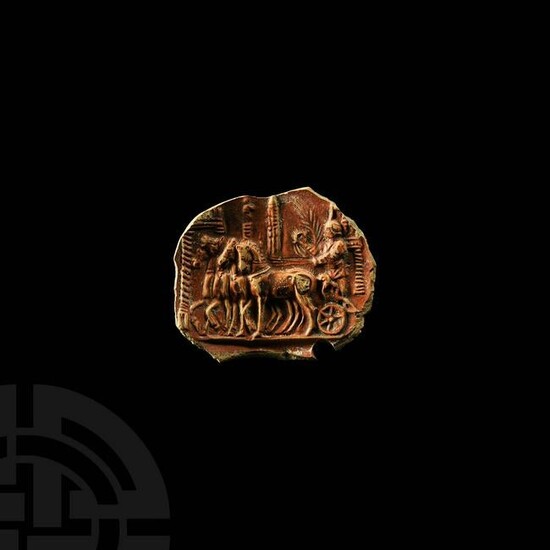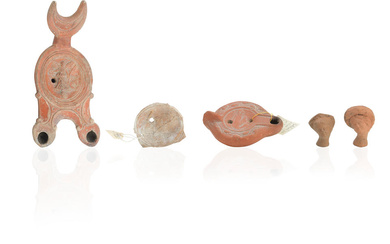Roman Terracotta Lamp Fragment with Victory Quadriga in
4th century AD. A clay lamp fragment with red slip, depicting a victorious quadriga in a hippodrome, the Auriga standing on the chariot and holding the crown of victory, depicted helmetted with a kamelaukion, the body girdled with aurigarion; obelisk and structures of the circus in the background. For a detailed representation of the costume of the Auriga see Mordtmann, A., 'Das Denkmal des Porphyrius', in Mittheilungen des deutschen archäologischen Institutes in Athen, vol. V, Athens, 1880, pp.295-308; Vasiliev, A.A., 'The monument of Porphyrius in the hippodrome at Constantinople' in Dumbarton Oaks Papers Vol. 4, (1948), pp.27-49. 10.1 grams, 59mm (2 1/4"). Property of a gentleman from Vienna; from his private collection formed since 1970. The extraordinary importance of this piece is in the representation of the hippodrome, with an Egyptian obelisk that is usually only associated with the Circus Maximus in Rome or the Hippodrome of Constantinople. The detailed representation of the Auriga shows the attributes of his work: he wears a close-fitting undershirt with sleeves (?????????i??) and an ornamented sleeveless tunic over it, leaving the knees exposed as is typical for charioteers (??????????"). This tunic was bound around the waist with a fascia (band, girdle), and was divided at the centre of the chest by a vertical line. Over the tunic, around his waist, a broad belt (??????) is visible, which had an elaborate fastening, formed by a cord laced crosswise through six rings and pulled tight. [No Reserve]
Condition Report: Fine condition.
View it on
Sale price
Estimate
Time, Location
Auction House
4th century AD. A clay lamp fragment with red slip, depicting a victorious quadriga in a hippodrome, the Auriga standing on the chariot and holding the crown of victory, depicted helmetted with a kamelaukion, the body girdled with aurigarion; obelisk and structures of the circus in the background. For a detailed representation of the costume of the Auriga see Mordtmann, A., 'Das Denkmal des Porphyrius', in Mittheilungen des deutschen archäologischen Institutes in Athen, vol. V, Athens, 1880, pp.295-308; Vasiliev, A.A., 'The monument of Porphyrius in the hippodrome at Constantinople' in Dumbarton Oaks Papers Vol. 4, (1948), pp.27-49. 10.1 grams, 59mm (2 1/4"). Property of a gentleman from Vienna; from his private collection formed since 1970. The extraordinary importance of this piece is in the representation of the hippodrome, with an Egyptian obelisk that is usually only associated with the Circus Maximus in Rome or the Hippodrome of Constantinople. The detailed representation of the Auriga shows the attributes of his work: he wears a close-fitting undershirt with sleeves (?????????i??) and an ornamented sleeveless tunic over it, leaving the knees exposed as is typical for charioteers (??????????"). This tunic was bound around the waist with a fascia (band, girdle), and was divided at the centre of the chest by a vertical line. Over the tunic, around his waist, a broad belt (??????) is visible, which had an elaborate fastening, formed by a cord laced crosswise through six rings and pulled tight. [No Reserve]
Condition Report: Fine condition.





